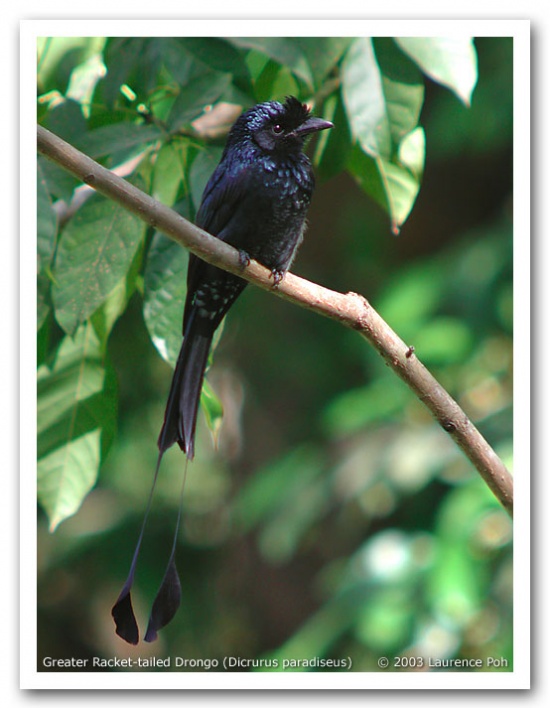Alternative names: Greater Racquet-tailed Drongo; Large Racquet-tailed Drongo
- Dicrurus paradiseus
Identification
30 - 65cm, depending on tail length.
- Black plumage with metallic blue or greenish-blue gloss
- Arching, helmet-like crest
- Notched tail with long, whorled rackets (sometimes damaged or missing)
- Blood-red eye
Sexes similar. Immatures are browner, less glossy, have a brown eye and a shorter tail with smaller tail-rackets.
Similar species
Lesser Racket-tailed Drongo has a rounded tail with flat rackets and a distinctly flat-headed appearance.
Distribution
Found in the Himalayas from North India east to Nepal, Bhutan, southern China (Tibet, Yunnan, Hainan); on the Indian Subcontinent, Sri Lanka, Burma, Indochina and south to Malaysia, Sumatra, Java, Bali and Borneo.
Common in parts of its range. Rare on Hainan.
Taxonomy
Subspecies[1]
- largest of all subspecies
- D. p. rangoonensis: Central India and Bangladesh to southern Burma, north and northeast Thailand, central Laos and central Vietnam
- with a very large crest and large and sharply defined breast spangles
- D. p. paradiseus: Southern India, southern Burma, Thailand and southern Indochina
- D. p. johni: Hainan (southern China)
- crest more upward curving
- D. p. hypoballus: Northern Malaysia
- well-defined spangles on brest
- similar to hypoballus but with a bushy tuft rather than a short crest
- D. p. ceylonicus: Sri Lanka
- similar to nominate but smaller
- D. p. otiosus: Andaman Islands
- like rangoonensis but without crest
- D. p. nicobariensis: Nicobar Islands
- similar to nominate but with smaller tail-racket
- D. p. banguey: Islands off north Borneo
- similar to brachyphorus but with longer wings
- D. p. brachyphorus: Borneo
- smallest subspecies, no crest, rackets often missing or abnormal developed
- D. p. microlophus: North Natuna Islands
- often with a short bushy tuft
- very small, short crest curving backwards on to crown, long tail-rackets
Has been placed in the genus Dissemuroides in the past.
Habitat
Forest , forest edges, plantations, wooded gardens. Occurs up to 1500m in India.
Behaviour
If territorial, is aggressive and will mob intruders, even large raptors and hornbills.
Diet
Found usually in the middle storey. Like most drongos, hawks after insects from open perches.
Breeding
Breeding season mainly from April to July. Pairs apparently stay together their whole lives. The nest is a small cradle made of fine twigs, rootlets, grass stems and other vegetable fibres. It's placed 5 - 15m above the ground in a tree. Lays usually 3 eggs. Brood parasitism by Indian Cuckoo reported.
Vocalisation
A superb mimic of the calls of other birds but always has a metallic sound.
References
- Clements, JF. 2011. The Clements Checklist of Birds of the World. 6th ed., with updates to August 2011. Ithaca: Cornell Univ. Press. ISBN 978-0801445019. Spreadsheet available at http://www.birds.cornell.edu/clementschecklist/downloadable-clements-checklist
- Del Hoyo, J, A Elliott, and D Christie, eds. 2009. Handbook of the Birds of the World. Volume 14: Bush-shrikes to Old World Sparrows. Barcelona: Lynx Edicions. ISBN 978-8496553507
- Rasmussen, PC and JC Anderton. 2005. Birds of South Asia: The Ripley Guide. Barcelona: Lynx Edicions. ISBN 978-8487334672
Recommended Citation
- BirdForum Opus contributors. (2025) Greater Racket-tailed Drongo. In: BirdForum, the forum for wild birds and birding. Retrieved 5 January 2025 from https://www.birdforum.net/opus/Greater_Racket-tailed_Drongo





